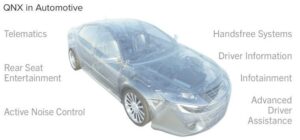Did you know that QNX has been around for more than 30 years and has been a part of the Blackberry family for four? And it has been involved in the automotive landscape for ten years. QNX is the underlying software for many platforms in the telecommunications, automotive, medical instrumentation, automation and security industries. So chances are you are using a product that incorporates their software without even knowing it.
For the purpose of this article I will focus on the automotive segment. As I’ve spoken with various players in the connected car space, it seems that there is still a lot of segregation between the way information is presented about the car performance itself and the infotainment services. One of the interesting points in the QNX solution is the ability to integrate this information into a single screen interface.
 If you review the automotive offers QNX is currently offering, there are solutions in all of the following areas: telematics, rear seat entertainment, active noise control, handsfree, driver information, infotainment and advanced driver assistance systems (ADAS). These factors combined focus on the performance, reliability, efficiency, safety and driving experience within the car.
If you review the automotive offers QNX is currently offering, there are solutions in all of the following areas: telematics, rear seat entertainment, active noise control, handsfree, driver information, infotainment and advanced driver assistance systems (ADAS). These factors combined focus on the performance, reliability, efficiency, safety and driving experience within the car.
Infotainment is a hot area of growth today, with consumers wanting to do more in their car and the mobile industry — handset vendors, mobile operators and app providers — all trying to stake a claim in this space. So who controls what happens here? The reality is that it differs by automobile OEM and local regulation. From a QNX perspective, it doesn’t matter. The software is intended to provide the tools to create a solution based on the individual requirements of the OEM.
For example, the control of infotainment content could be managed by the consumer’s mobile device or the car. Same with the music or video content. Although a third option here is that this content could reside in the cloud. As far as the apps in the car, there are safety implications as to what is allowed of course, but moving beyond that they can also be enabled via the options mentioned above. Wi-Fi hotspot on wheels, no problem either. QNX provided a demonstration for RCR Wireless as to the options enabled through its software tools and there’s quite a wide range of functionality.
Wondering how all this might look in reality? The latest Audi TT is an example of how everything can be integrated into a single screen in the car. You can see this working in a demo of the Audi finished product in the video below.
There are a great deal of exciting developments happening in the Connected Car space every day. It seems to me that only our imagination is the limit. As more research firms conduct studies to determine the end users’ desires in this space and the OEM manufacturers and their underlying vendor partners continue to evolve their platforms, there should be many exciting developments in the future. Think about linking your in-car experience to your life outside of the car. Does your car soon become an extension of your home and office? A rolling combination of your workspace and your living room? Maybe this happens sooner then you think.

